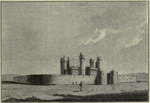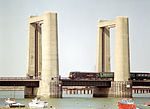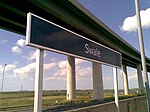Rushenden
Borough of SwaleIsle of SheppeyKent geography stubsVillages in Kent

Rushenden is a village on the Isle of Sheppey in the Borough of Swale in Kent, England, of approximately 500 dwellings. It lies to the south of Queenborough (where, at the 2011 Census, the population was included). A railway spur line formerly passed through the village to a former wharf on the Swale, although this has now been removed to make way for part of the regeneration scheme.
Excerpt from the Wikipedia article Rushenden (License: CC BY-SA 3.0, Authors, Images).Rushenden
Alsager Avenue, Borough of Swale Queenborough
Geographical coordinates (GPS) Address Nearby Places Show on map
Geographical coordinates (GPS)
| Latitude | Longitude |
|---|---|
| N 51.41 ° | E 0.74 ° |
Address
Alsager Avenue
Alsager Avenue
ME11 5JN Borough of Swale, Queenborough
England, United Kingdom
Open on Google Maps






